Table of Contents
The crypto market is pure survival of the fittest, or better yet, survival of the most innovative. With tens of thousands of coins fighting for attention, most fade into the background, while only the strongest survive.
To stand out, a token has to offer something useful, real, and valuable. One of such tokens is Stellar (XLM), a token that promises to make it faster, cheaper, and smarter to move money.
Imagine sending cash abroad in seconds instead of days, and for less than the price of a stick of gum. That’s exactly what Stellar (XLM) offers. It sounds very impressive, but is it really worth your time, and should it make it into your portfolio? Let’s find out.
What is Stellar (XLM)?

Stellar is a blockchain network that helps people move money quickly and cheaply across borders. Like a digital highway for payments. It was launched in 2014, co-founded by Jed McCaleb and Joyce Kim.
Jed, who earlier co-founded Ripple, felt that Ripple was becoming too focused on serving banks and big financial institutions. So, he broke away to start Stellar with a different mission: to give everyday people, especially in developing countries, a faster and cheaper way to send, receive, and exchange money without relying on expensive banks or middlemen.
The token that powers this network is called XLM (short for Lumens). Think of Stellar as the road, and XLM as the fuel that keeps cars moving on it. Without XLM, transactions on the Stellar network wouldn’t work.
Today, Stellar has grown into a global payment network. It now processes millions of transactions every day and has partnered with companies like IBM and MoneyGram to power real-world cross-border payments.
What Makes Stellar Different Among Other Crypto Assets
In a sea of thousands of tokens, what makes Stellar stand out? The answer is its focus on real-world money movement instead of just speculation.
Most cryptocurrencies are built with their own goals in mind. Bitcoin wants to be digital gold. Ethereum powers smart contracts and decentralized apps. Ripple (XRP) leans toward serving banks. But Stellar’s focus has always been clear: cheap, fast payments for everyday people.
Here are the ways Stellar sets itself apart:
1. Speed
Stellar’s transactions usually settle in 3–5 seconds. Compare that to banks or remittance services that drag on for 3–5 business days. Even Bitcoin can take 10 minutes to an hour, and Ethereum slows down when the network is busy. With Stellar, your money moves at the speed of a text message.
2. Ultra-cheap Fees
Each Stellar transaction costs about $0.00001, almost free. Banks and remittance services can swallow $20–$35 per transfer, while Ethereum’s gas fees often spike to a few dollars. Stellar does its best to keep your money where it belongs: in your pocket.
3. Accessibility
Stellar was designed for regular people, especially in developing countries, who need an affordable way to send money across borders. While Ripple (XRP) mainly courts banks and big institutions, Stellar makes sure that someone in Nigeria, India, or Mexico can send money abroad without losing a big chunk to fees, making global transfers more inclusive.
4. Trusted Partnerships
Stellar isn’t just a nice idea. It has partnered with big names like IBM and MoneyGram, as well as fintech firms, to power real-world payments. These collaborations give Stellar credibility and help push its technology into the hands of millions of users.
5. Community-Driven Growth
Unlike some blockchains where the foundation decides everything, Stellar has a more democratic approach where the community votes on which projects get funding. This ensures that innovation comes from the ground up, making the ecosystem more inclusive and aligned with user needs.
Why Choose Stellar for Crypto Investment
When it comes to crypto investing, most people think first of Bitcoin or Ethereum. But smart investors know that diversifying into promising altcoins can balance risk and increase opportunities.
Here are some reasons to keep an eye on Stellar:
1. Peer-to-Peer Freedom
Stellar lets you send money directly to anyone, anywhere, no banks, no middlemen, no hidden fees. This kind of decentralized independence is what drew many people to crypto in the first place, and Stellar has stuck to that mission since 2014.
2. Security & Wallet Options
Stellar isn’t just fast, it’s secure. You can store XLM safely in trusted wallets like Lobstr, Scopuly, or Stellarterm, putting you in control of your funds. Unlike money in a bank account, your tokens remain yours, protected by blockchain technology.
3. Easy to Trade
Because Stellar is listed on most major exchanges worldwide, getting in or out of your investment is hassle-free. Whether you want to cash out, trade for another token, or just hold for the long term, liquidity is never a problem.
4. Future Growth Potential
Stellar will continue to evolve. With upgrades like Soroban smart contracts, developers can build new financial applications on its network. Many fintechs and companies are also looking to adopt Stellar as a solution to cross-border payments. Then, add in the fact that some analysts see its price reaching $0.65–$1.50 by the end of 2025 (though predictions are never guaranteed). For investors, that means there’s still upside potential.
Is Stellar (XLM) Safe?
“Safe” is not a word we can comfortably use when it comes to investing in crypto. No cryptocurrency is risk-free, but Stellar has some features that make it more reliable than many tokens out there:
1. Network Safety
Stellar uses the Stellar Consensus Protocol (SCP), a system designed to keep the network secure and decentralized. Instead of depending on expensive mining like Bitcoin, SCP confirms transactions in seconds while ensuring:
- Decentralized control – no single company or person can dominate decisions.
- Fast Confirmation – transactions are settled almost instantly.
- Flexible trust – users can choose which validators they trust.
- Strong security– even if bad actors join, they can’t take over the network.
This means transfers are not only cheap and fast but also backed by a system that’s hard to corrupt and energy-efficient.
2. Investment Safety
As an investment, Stellar carries the same risks as other cryptocurrencies:
- Volatility – Like every crypto, Stellar’s price can swing wildly in a short time. XLM once hit an all-time high of $0.93 in 2018, but later dropped below $0.10.
- Regulation – Governments are still figuring out how to treat cryptocurrencies, and new rules could affect Stellar’s adoption.
- Competition – Stellar faces strong rivals, from Ripple (XRP) to stablecoins, and even central bank digital currencies (CBDCs).
- Adoption hurdles – long-term success depends on businesses and individuals actually using it.
Bottom line: Stellar is not a “get-rich-quick” coin. It works best as a tool for cheap, fast payments with steady, practical use cases. If you’re looking for reliability and real-world purpose in crypto, Stellar is safer than many speculative tokens, but it still comes with the risks of the broader market.
Where to Buy Stellar Token
You can buy Stellar (XLM) on almost all major crypto exchanges, including:
- Binance
- Coinbase
- Kraken
- KuCoin
For storage, you have options:
- Hot wallets (e.g., Trust Wallet, Coinbase Wallet) for convenience
- Cold wallets (e.g., Ledger, Trezor) for extra security
Frequently Asked Questions (FAQs) About Stellar (XLM)
Can Stellar replace banks for cross-border payments?
Stellar cannot entirely replace banks for cross-border payments. But for quick, low-cost transfers, it is a practical alternative.
What determines XLM’s value?
Stellar’s value is mostly determined by demand, adoption of the Stellar network, partnerships, and overall crypto market trends. If more people and businesses use it for sending money or payments, demand goes up and the price can rise
Can I stake or earn rewards with Stellar (XLM)?
No, you can’t directly earn staking rewards with Stellar. Stellar doesn’t use Proof of Stake, so there are no traditional staking rewards. Although some exchanges may offer interest to people who hold Stellar.
Can I convert XLM to other currencies easily?
Yes, you can convert XLM to other currencies easily. Stellar supports multi-currency transfers, and most exchanges let you swap XLM for fiat or other cryptocurrencies instantly.
Can I use Stellar for everyday payments?
Yes, you can use Stellar for everyday payments. Stellar’s low fees and fast transaction times make it practical for everyday transactions, like paying freelancers abroad, sending money to family, or even making small online purchases.
Is Stellar better than Ripple?
Not particularly. Stellar and Ripple are cousins with different goals. Ripple targets banks, while Stellar focuses on everyday people. Since they target different users and work differently, it’s not really about which is better; it depends on what you need.
Conclusion
Stellar (XLM) isn’t the flashiest coin in the market, but it might be one of the most practical. With instant transfers, rock-bottom fees, and big-name partnerships, it positions itself as a serious player in the future of global payments.
That said, like all cryptocurrencies, Stellar comes with risks, which means it’s not a guaranteed path to profit. If you decide to invest, treat it as a long-term play with practical use cases, not a get-rich-quick scheme.
In short, Stellar shines when you focus on its utility and innovation. For anyone looking to send money across borders, experiment with crypto payments, or diversify their crypto portfolio, Stellar is a token worth knowing about.
Last updated on September 16, 2025

